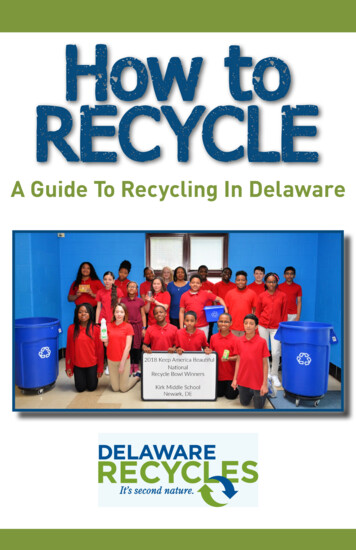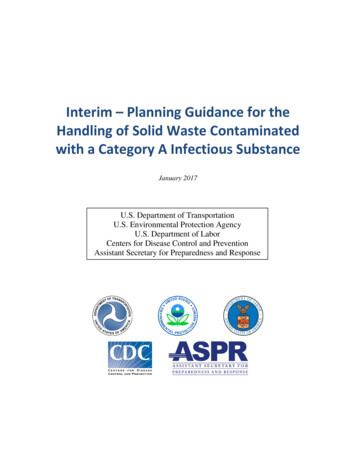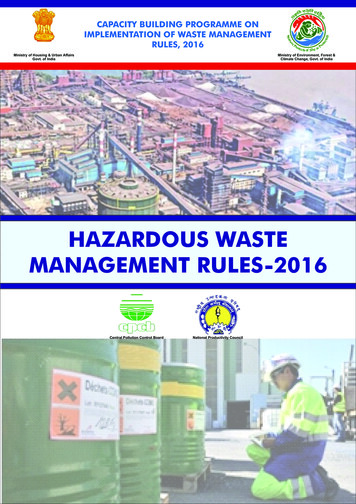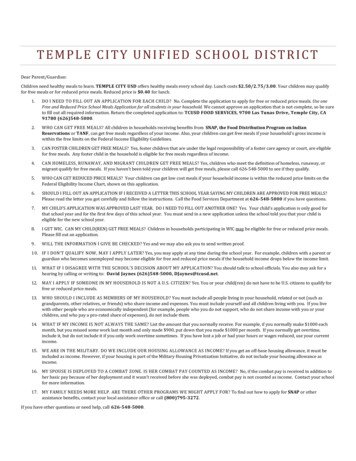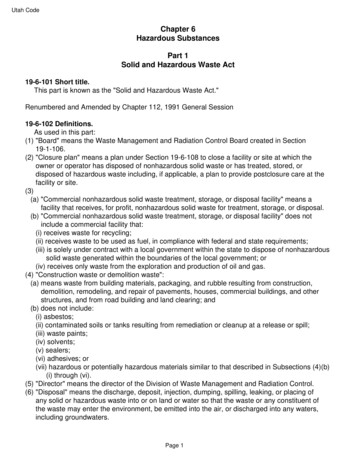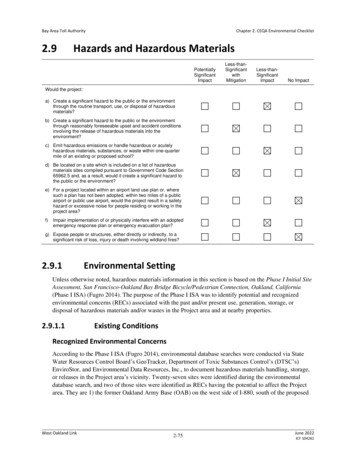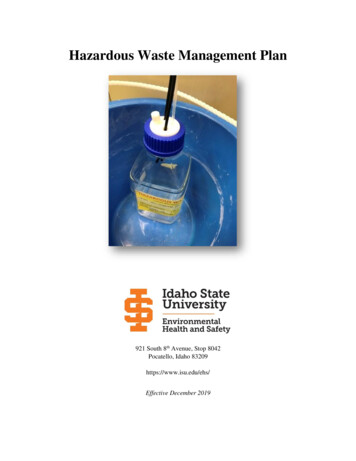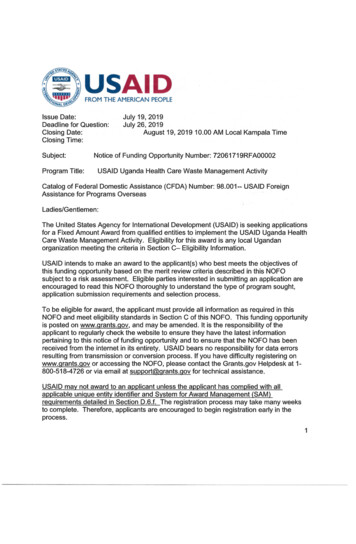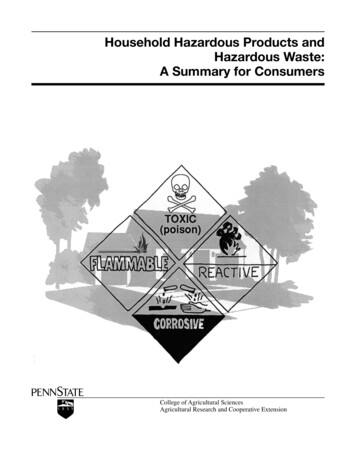
Transcription
Household Hazardous Products andHazardous Waste:A Summary for ConsumersCollege of Agricultural SciencesAgricultural Research and Cooperative Extension
ContentsPageI.What are Household Hazardous Products and Waste?.1A. Hazardous Waste—Not Your Ordinary Pile of Trash .1B. Household Hazardous Waste and Products .1II.The Route of Household Hazardous Waste . .3A. Household Hazardous Waste and the Environment .3 Improper Disposal of Household Hazardous Waste .3 How Long Will Hazardous Waste Be Hazardous? . .5 Household Hazardous Waste and the Water Cycle .5B. Hazardous Products and the Human Body . .6 How Do Hazardous Substances Enter Our Bodies? .6 Toxins in the Body .7 Toxicity: A Relative Term .8III.IV.Household Hazardous Products: Problems and Solutions .8A. Looking at Labels . .8B. Specific Types of Household Hazardous Products .9 Automotive Products .9 Cleaning and Polishing Products .11 Paint and Related Products .13 Pesticides . .14 Miscellaneous Household Hazardous Products .16C. Reduction Begins at Home .17D. Reduction Risks: General Safety Guidelines for Hazardous Products .17How Is Household Hazardous Waste Managed? .19A. Hazardous Waste Management .19B. Household Hazardous Waste Management .20C. Source Reduction .21Appendix A: Alternative Household Cleaning Solutions .22Sources.24
I. What Are HouseholdHazardous Products and Waste?A. Hazardous Waste—Not YourOrdinary Pile of TrashA lesser‑known crisis, however, is just beginningto unfold. Upon examining the types of householdand small business waste, we are becom ing awarethat these wastes are the same type of hazardouswaste generated by large industry. Al though the actualamount of hazardous waste coming from one house orbusiness may be small, the cumu lative amount from allthe households and small businesses in the U.S. addsup to a profound threat to the environment. There arefew laws governing hazardous waste from households.Therefore, this waste may legally enter disposal facilities that are not equipped to treat it.Household hazardous waste (HHW) is becoming the next focus of municipal waste manage ment. Aswe look for ways to reduce the volume of the trash wegenerate, we must also examine how we can reduceits toxicity. The exact amount of house hold hazardouswaste generated per person is un known. Estimates putthe range at 3–10 gallons per household per year (orthe equivalent of approxi mately 6 pounds of householdhazardous waste per person per year). Some stateshave taken initial steps to reduce the environmentalimpact of household hazardous waste by banningcertain types from landfills, educating consumers onhazardous products, and requiring product manufacturers to decrease the amount of hazardous substances inconsumer products.Hazardous waste. The term brings to mind images ofLove Canal (New York) residents forced to leave theirhomes and clean‑up crews dressed like astronautsin protective clothing. This is scary stuff. A total of32,000 hazardous waste sites have been logged in theU.S. Environmental Protection Agency (EPA) inventory (1990). Hazardous waste generated by industryhas gained national attention. As a nation, we havebegun to take steps toward proper management ofthese materials. In the last ten years the disposal of industrial hazardous waste has become highly regulated.Although the problem is far from resolved, progresshas been made.How Is Hazardous Waste Regulated?The term hazardous waste has a legal meaning.Any waste that is toxic, flammable, corrosive,reactive, radioactive, infectious, or has beenspecifically identified by the EPA is consideredhazardous. Basically, the amount of hazardouswaste generated, not the type, deter mines howstrictly the waste is regulated. Large quantitygenerators are those industries and businessesthat generate more than 220 pounds of hazardous waste and/or 2.2 pounds of acutely hazardous waste per month. Large quantity generatorsare highly regulated by both federal and statehazardous waste laws.Small quantity generators (SQGs) arethose businesses, institutions, and agenciesthat generate less than the above amount. Thetypes of SQGs are surprising. Examples includefarms, some craft businesses (pottery, glassworking), auto dealerships, service stations,transportation services (bus, taxi fleets), cleaning services (carpet and upholstery cleaning,dry cleaning), printing companies, photographylabs, golf courses, and even some schools.B. Household Hazardous Wasteand ProductsHousehold hazardous waste is the unwanted portionsof those products that contain hazardous ingredients.Hazardous products generally fall into five categories: automotive, cleaning and polishing, paint andrelated solvents, pesticides, and miscellaneous items(examples include batter ies, fingernail polish remover,some cosmetics, and shoe polish). These productsare considered hazard ous because they can be toxic,flammable, corrosive, and/or cause violent chemicalreactions.1
What Makes Something Hazardous?A material is considered hazardous if it is radioactive, has dangerous biological characteristics, or has certain chemical properties. This guide focusesonly on those materials that are considered hazardous because they arecorrosive, reactive, flammable, and/or toxic. Many hazardous productshave more than one of these hazardous characteristics.Corrosive materials destroy metal surfaces and living tissues. They chemically change what they touch. Practicallyeveryone in the northern states has seen corrosion inone form or another. Road salt used on icy roadsis famous for its ongoing “corrosive” relationshipwith automobiles. Corrosive substances are acidic(pH less than or equal to 2) or caustic (pH greater thanor equal to 12.5). Some examples of corrosive materials are oven cleaner (sodium hydroxide), bathroom cleaner(phosphoric acid), and pool chemicals (hydro chloric acid).Reactive materials are very unstable and interact with the substancesaround them. They are explosive, and can sometimes create toxic fumes.Examples of reactive materials found in the home or school are picric acid(formerly used in science labs), welding material (calcium carbide), and certainrodenticides (zinc phosphide).Flammable materials will burst into flames if they come into contact with sparks orflames at certain temperatures. The temperature at which this happens is referred to asthe flash point. Flammable liquids have a flash point of 140 Fahrenheit. Examples ofignitable materials found in the home are nail polish (acetone), paint remover (toluene,xylene), and hair spray (butane).Toxic materials cause immediate or long‑term negative health problems. Exposure totoxic materials may result in injury, illness, or death. Examples of toxic materials foundin the home are paint stripper (methylene chloride), pesticides (chlordane), and woodpreservatives (pentachlorophenol).In some cases, the only difference between someof the hazardous chemicals used in some industrialprocesses and those used in consumer products is thatconsumer products contain smaller amounts and/ordilute concentrations. For example, the industrialstrength solvent methylene chloride (suspected to causecancer) is sometimes used in oven cleaners but isregulated when used as a pesticide in larger quantities.Household hazardous products cause prob lemsin both their use and disposal. They pose health risksduring use. If the unwanted portions of these productsgo down the drain, into the trash, or get burned, theymay threaten the environment.2
II. The Route of HouseholdHazardous WasteA. Household Hazardous Waste andthe EnvironmentSince the chemical makeup is vastly differ entamong the different types of household hazard ouswaste, one cannot make a general statement aboutwhat happens to household hazardous waste in alandfill environment. The long‑term effects of household hazardous waste in landfills are unknown becausestudies are so recent.Improper Disposal of HouseholdHazardous WasteMost household hazardous waste is eventu ally landfilled or incinerated, dumped directly on the ground,or poured down drains (entering septic systems orsewers). Disposing of household hazard ous waste inthese ways threatens environmental quality.IncineratorsAlthough incinerators are equipped with pollutioncontrol devices, some pollutants found in hazardouswaste are difficult to capture. Some components ofthe household hazardous waste stream are particularlytroublesome. For example, at the high temperaturesthat occur during incineration, mercury (found in somedry cell batteries, fluorescent light bulbs, and old paint)can change into a gas and be emitted through the stackof the incinerator. There is controversy about howeffective incinerators are in capturing all pollutants.Some believe that existing air pollution control equipment, such as “scrubbers,” is effective at capturing pollutants before they leave the stack. However, the mostefficient technology (spray dry/fabric filter) can onlyremove 75–85 percent of the mercury. Airborne mercury is soluble in water and finds its way into lakes,streams, and groundwa ter, where it can enter the foodchain. Also, the ash left over from incinerator burningmay contain concentrated amounts of some hazardouschemicals.Once airborne, hazardous substances may reactwith other contaminants and form a new substance,become dissolved in water droplets, and eventually fall to the earth as rain or as larger par ticles (dryprecipitation). The amount of time a material is inthe atmosphere depends on how stable it is. Unstablecompounds, such as carbon monoxide, are short livedin the atmosphere. Stable compounds remain in theatmosphere for long periods of time and can causemuch damage.1. Into the TrashAnything that gets thrown away with the regular trashis landfilled, incinerated, or composted.LandfillsLandfills are not isolated; they are connected to the environment. Rain, snow, and other precipita tion enterslandfills and mixes with the landfill contents, includinghazardous wastes. If the hazard ous waste is water soluble, then it will be dissolved and carried wherever thewater takes it. If it is not water soluble, it will probablyremain intact and travel suspended in the water. Thiscontaminated water (called leachate) trickles downthrough the layers of trash and can enter the environment if it does not encounter any type of barrier.Even lined landfills are not designed to treathazardous waste. Some types of hazardous wastescan destroy the synthetic liner, making it ineffective.Leachate contaminated with hazardous waste cannotbe completely cleaned at the wastewater treatmentfacilities to which it is sent. Leachate, contaminated byhazardous waste, can potentially enter the water cycle.Landfill conditions influence what happens tohousehold hazardous waste. The amount of oxygenand moisture in the landfill and the surround ing soilcharacteristics affect how fast household hazardouswaste containers or metal battery casings will degrade.Water in a landfill may also react with different typesof hazardous waste. For example, lithium, found in atype of dry cell battery, may react violently with waterfound in a landfill.Co‑compostingMany towns are considering co‑composting (composting “regular trash” with “traditional com post material”).3
2. On the Groundspaces of clay soils. Geological factors (rock formations, fractures, faults) also affect the direction andextent of hazardous waste movement. Thus, householdhazardous waste that is dumped may contaminate thesurrounding soil or percolate down and poten tiallycontaminate groundwater.If dumped directly on the ground, the first thing household hazardous waste will encounter is soil. Hazardousmaterials must be dissolved or suspended into liquidbefore moving through soil. How thick this solution ormixture is (its viscosity) determines how fast it moves.Soil type also influ ences how fast and how far household hazardous waste will travel. Soil characteristicssuch as porosity (the amount of space between the soilpores) influ ence the contaminated water’s movement.The larger pore spaces found in sandy soils permiteasier movement of moisture than do the smaller3. Down the DrainAnything that is poured down the drain enters eithera septic system or a wastewater treat ment facility andultimately enters the water cycle.How Do SepticSystems Operate?Primary TreatmentOnce entering the septic tank,wastes separate out according todensity. Solids settle to the bottom.Oils, grease, and other lighter‑than‑watermaterials float to the surface and form a scumlayer. The primary cleaning treatment is the actionof bacteria found in the waste, which digests organiccompounds. Wastewater leaves the tank and drains intothe leach field.Secondary TreatmentThe leach field consists of perforated distribution pipes, which distribute the wastewater beneath theground’s surface into the surrounding soil. Soil particles physically or chemically attract and retainsewage nutrients, metals, and pathogens. Microorganisms living in the soil further break down thewaste. Periodically, septic tanks must be pumped out in order to operate effectively.4
Septic SystemsSeptic Tank AdditivesThe septic system, located “on site,” treats a building’swastewater before releasing it back into the environment. However, like incinerators and landfills, septicsystems are not designed to treat hazardous waste.Hazardous waste, including excessive amounts ofdrain openers and cleaners containing lye and strongbleach, may negatively affect the system’s naturalcleansing process by destroying bacteria needed toclean the water. Without these bacteria, certain pathogens will travel through the system unchanged. Sincethe system is not designed to treat chemical waste,household hazardous waste passes through the systemun changed and can potentially contaminate groundand surface water.Septic tank additives, marketed as ongo ingmaintenance or remedies for septic tank problems, can actually do more harm than good.Some septic maintenance products are bannedin many states, as they contain dangerouschemicals that can destroy a leach field andcontaminate groundwater. Consult professionals about leach field problems, rather than usinghazardous additives.and cadmium (batteries, plastics, appliances, electronics, and some pigments). Nonpersistent chemicals(such as ethylene glycol, the primary ingredient inantifreeze) undergo physical and chemical changes inthe environment. These chemicals may break down orbecome diluted to the point where they are no longerharmful to the environment.Wastewater Treatment FacilitiesWastewater treatment facilities operate on the sameprinciple as septic systems, except on a much largerscale. Wastewater from residences and businesses istreated at a central location, rather than on site. At thecentral location, wastewater goes through a series oftreatments before it is released into local water sources. Wastewater treatment facilities are notdesigned to treat hazardous wastes.Treatment processes include:Household Hazardous Waste andthe Water CycleUltimately, the improper disposal of house hold hazardous waste leads to its entrance into the water cycle.Precipitation falls to earth, entering oceans, lakes, andstreams or trickling down through the soil. That waterthat enters the soil may travel until it reaches an impermeable barrier (such as bedrock). This water collectsunderneath the earth’s surface and is called groundwater. It is stored in the sur rounding sand, gravel, orother sediment.Groundwater is not the final resting place forwater. Although it moves very slowly, groundwater isconstantly on the move. Groundwater eventually flowsto the surface (streams, springs, swamps, ponds, orlakes), where it evaporates into clouds or is taken intoliving things. The whole process then starts over again.It is this constant cycle between surface water andgroundwater that spreads water pollution. Screening to remove large objects and sand Primary settling to allow the solids to settle assludge and to skim grease off the top Aeration to allow air to circulate, which facilitatesthe breakdown of wastes Final settling to remove sludge after it settles outcompletely Disinfection to further purify water by add ingchlorine; further water treatment, such as adjustingthe pH level, may be necessaryHow Long Will HouseholdHazardous Waste Be Hazardous?How long a hazardous material remains active in theenvironment depends on its indi vidual characteristics.If it is persistent, it will remain unchanged for significant time periods. Persistent chemicals move throughfood chains, concentrating in the tissues of organismsat each step in the food chain (called bioaccumulation). Heavy metals are persistent in the environment.The most common heavy metals found in the wastestream are mercury (dry cell batteries, fluorescentlight bulbs); lead (batteries, motor oil and filters, leadsolder on light bulbs and circuit boards);Why Should You Be Concerned AboutGroundwater Contamination?Between 40 and 50 percent of the U.S. population depends on groundwater as its primarydrinking water source. Over 37 percent of Pennsylvanians rely on groundwater for their primarysource of water. In rural areas, almost everyonedepends on ground water.5
The Water CycleHow Do Substances Enter Our Bodies?Groundwater contamination occurs when polluted surface water or precipitation percolates throughthe soil. Since groundwater constantly interacts withthe entire water cycle, contamination spreads easily.Since this cycle is continuous, con taminated groundwater can also feed and contami nate lakes, ponds, andstreams.Substances enter our bodies through our mouths (ingestion), our skin and eyes (absorption), or our noses(inhalation). All these ways bring toxic substancesinto our bloodstream. Once in the bloodstream, toxicsubstances are carried to cells all over our bodies.If we ingest toxic substances, they enter ourdigestive system. After passing through our stom ach and intestines, substances enter our blood stream.Substances that directly contact our skin and eyes candamage them at the point of contact or pass into ourbloodstream. Inhaling toxic substances causes the mostdamage to humans. After sub stances are inhaled, theytravel to our lungs. Since the lungs are composed ofhighly permeable tissues, toxic substances are easilyabsorbed into our bloodstream.B. Hazardous Products and theHuman BodyOur bodies are constantly interacting with the environment. That environment contains both helpful andharmful substances. Hazardous products in our environment may contain toxic ingredients that may harmour bodies.Consider ThisAlmost every chemical can be toxic in excessiveamounts or in high concentrations. It is oftenthe dose that determines a substance’s lethality(the amount that causes death). For example,the “average‑size adult” would die if he/sheingested at one time 32 gallons of water or 100cups of coffee (caffeine) or between 100 and400 pounds of potatoes (solanine).6
Toxic Substances and the Human BodyMethylene ChlorideMethanol (wood alcohol)(organic solvent found inpaint and varnish removers,pesticides, and degreasers)Suspected human carcinogen; aggravates heartconditions, possibly causingheart attacks(solvent found in antifreeze,paints, and windshield wiperfluids)Highly toxic and readilyabsorbed through all routes ofexposure; blindness or deathmay occur following ingestionCadmium(heavy metal found in paintpigments, rechargeablebatteries)Causes kidney and bonedamage; persistent in thebody; accumulates in thefood chainBenzene(a type of petroleum distillatefound in some varnishes, lacquers,paint removers, and gasoline)Rapidly absorbed by blood;gains access to vital systems;carcinogen; causes central nervoussystem disorders; powerful bonemarrow poisonToxins in the BodyOur bodies have several ways of dealing withingested, absorbed, or inhaled toxins. Some toxins canbe excreted in unchanged forms and leave the bodythrough exhaled air, perspiration, feces, urine, tears,vomit, hair, and breast milk. Toxins can also be modified so that they are water soluble and can be removedby the kidneys. Some toxins, in small doses or lowconcentrations, are metabolized and their toxic properties are lessened. Some toxins do not leave the bodyand accumulate in various parts of the body, such asfat tissues and bones. This process of accumulation inbodies is how some toxic chemicals are able to movethrough the food chain. These toxins become moreconcentrated as they move up the food chain from preyto predator.A toxic substance can either affect the place where itenters the body (local) or have far‑reaching effects allover the body (systemic). A skin rash is one exampleof a local effect, and a change in heart rate or mentalconfusion are examples of systemic effects. Whenthe combined effect of two toxic substances is different from the sum of their indi vidual effects, this is asynergistic reaction.It is often difficult to know the true effects ofa particular toxic substance in the body because theeffects may not appear right away. A chronic, orlong‑term, health effect usually results from re peatedexposure to small amounts or low concentra tions of atoxic substance over the years. In contrast, an acutereaction is a short‑term effect and usually results froma single exposure to a high dose of a toxic substance.7
Toxicity: A Relative Term3. Gender—Some toxins have different effects onmales and females. Generally, women have a largerpercentage of fat in their total body weight, meaning they can accumulate more fat -soluble toxins intheir bodies than men.Toxicity is a relative term. The effects of hazardoussubstances vary greatly. Our reaction depends on howmuch of the substance we were exposed to, the concentration of that substance, the length of exposuretime, and our individual character istics. Characteristicsinfluencing toxicity include:4. Age—The very old and the very young are moresusceptible to the effects of toxic substances.Infants and young children have incompletelydeveloped systems. Since children have higherrespiration rates, they are more susceptible to toxinsthrough inhalation.1. Genetic factors—For example, the efficiency of thekidney can affect the ability to excrete toxins.2. Lifestyle of the individual—Smoking, alcoholconsumption, obesity, and previous medical historyall affect how the body handles toxins. In general,healthier individuals will be better able to fend offsome toxins.5. Allergic sensitivity—Many individuals who areparticularly sensitive to chemicals experi ence anallergic reaction to some toxic chemicals, even inlow amounts and concentrations.Ill. Household Hazardous Products:Problems and SolutionsA. Looking at LabelsHazardous products are regulated only in termsof their acute health effects. Chronic health effects arenot taken into consideration, and very few studies havebeen conducted to determine just how dangerous thoseeffects are.Trade secrecy laws allow manufacturers to omitlisting or specifically defining ingredients on labels ifdoing so would cause them economic loss. Manufacturers are required to disclose the exact product ingredients to physicians treating a patient. While this lawprotects manufacturers, it prevents consumers fromknowing exactly what they are buying.Federal regulations require that certain informationappear on hazardous product labels. The FederalHazardous Substances Act (FHSA) estab lishedlabeling requirements for consumer products containing hazardous substances, except for pesti cides. Thefollowing information is required to appear on hazardous products: Signal words (danger, warning, caution, poison).These three words give some hint of how hazardousa product is. Products labeled “Danger” are the mosthazardous and those labeled “Caution” are the leasthazardousVague LanguageManufacturers sometimes use generic terms or vaguelanguage rather than reveal the specific chemical identity of their products. Two common generic terms arepetroleum distillates and organic solvent. Petroleumdistillates are a broad range of compounds that aremade when crude oil is refined. Petroleum distillateshave varying degrees of toxicity, ranging from highlytoxic benzene to petroleum jelly (generally acceptedas nontoxic). Specific organic solvents similarly havea wide range of toxicity and flammability. Organicsolvents include acetone, isopropyl alcohol, andmethylene chloride. Description of the hazard associated with the product(for example: flammable, poison) Common chemical name for the hazardousingredients Instructions for safe use and handling First aid instructions Name and location of manufacturer or distributor “Keep Out of Reach of Children” statement or theequivalent8
Some “ingredients” listed on labels describe thefunction of the chemical ingredient (grease cutter, corrosion inhibitor, polishing agent) rather than telling theconsumer what specific chemical ingredi ents are used.B. Specific Types of HouseholdHazardous ProductsMisleading TermsIn the U.S. there are about 180 million cars, buses,and trucks on the road. There are hundreds of productsassociated with motor vehicle operation and maintenance that contain hazardous substances. Peoplewho do their own repair work (“Do-It-Yourselfers” orDIYs) need to be aware of those hazardous productsand what to do with them. When ever the number ofDIYs increases (for instance, when the cost of havinga car repaired and maintained rises), the likelihood ofimproper disposal of these hazardous fluids soars.1. Automotive ProductsSome terms may be deceptive, such as “active” and“inert.” The term “active” refers to those ingredientsthat actually do what the product is intended to do.“Inert” refers to any other sub stances in the product,usually the “vehicle” that makes the active ingredient easy to apply and allows it to perform the job.Consumers often assume that “inert” means nontoxic.Inert ingredients may be just as hazardous as the activeingredients, or even more so. For example, methylenechloride, a carcinogen, is often an inert ingredient indisinfec tants.Another misleading term that is used is “nontoxic.” It is important to note that “nontoxic” has noregulated definition and therefore the manu facturersmay use it as they desire.AntifreezeWhat Are the Problems?The primary ingredient in antifreeze is ethylene glycol,a highly toxic substance. Pets are particularly susceptible to ethylene glycol poisoning because theyare attracted to its sweet taste. Anti freeze eventuallybecomes ineffective in a radiator and needs to bechanged. If the resulting waste antifreeze is dumpedon the ground, it can contami nate ground and surfacewaters.Incorrect First Aid AdviceConsumers should never assume that first aid information listed on labels is correct. A study conducted bythe New York Poison Control Center found that 85percent of the product warning labels studied wereinadequate or incorrect. Call your local poison controlcenter for thorough first aid informa tion.What Are Some Solutions?Selling Alternative Products—It’s Not EasyBeing GreenLess Toxic AntifreezeLess toxic antifreeze has propylene glycol as the activeingredient, rather than ethylene glycol. There is a question, however, about propylene glycol’s effectivenessin extremely cold climates.It is difficult to determine if “green prod ucts” are trulyenvironmentally safe because many advertising claims(“green,” “environmentally friendly,” “nontoxic”)have no legal definition. Many of these products havenot been analyzed for their long‑term health andenvironmental effects.Recycling AntifreezeUsed antifreeze can be recycled, and its originalproperties can be reclaimed. Recycled antifreeze canbe used again as engine coolant or the ethylene glycolcan be extracted and reused in the plastics industry.Gas stations may accept small amounts of householdantifreeze. Most household hazardous waste collectionprograms accept waste antifreeze.Consumer ProtectionConsumers do have some legal protection aga
consumer products. B. Household Hazardous Waste and Products Household hazardous waste is the unwanted portions of those products that contain hazardous ingredients. Hazardous products generally fall into five catego-ries: automotive, cleaning and polishing, paint and related solvents, pesticides, and miscellaneous items
